St George's Hospital
Hyde Park Corner, SW1
Medical dates:
Medical character:
Acute.
Teaching hospital
St George's Hospital was established in 1733 following a schism with the Westminster Hospital.
The latter, having outgrown its premises, needed to move and two
possible locations were discussed. Most of the Governors
favoured a site at Buckingham Gate, while a few preferred
Lanesborough House, a mansion built in 1719 next to Hyde Park, then on
the edge of London. A row broke out (relationships between the
Governors and the medical staff had become increasingly difficult: the
Board considered the doctors as their inferiors, while the doctors
regarded the Board as inefficient and suffocating). A lease had
already been signed for Lanesborough House, and the entire medical staff
resigned and left to establish their own hospital there, taking many of
the subscribers of the Westminster Hospital with them.
St George's Hospital opened in 1734 with 30 beds in two wards (one for male and one for female patients) on the first floor and staff accommodation above.
It was an instant success. The freehold to Lanesborough House was purchased, along with adjoining houses, and the Hospital expanded rapidly. By 1747 the number of wards had increased to 15, with 250 beds available. A separate room was made available for operations (they had previously been carried out in the wards).
By 1800 Lanesborough House had fallen into disrepair, and a competition was held to design a new 350-bedded hospital. It was won by William Wilkins, the architect who also designed the National Gallery in Trafalgar Square. Between 1827 and 1834 Lanesborough House was demolished and the Hospital rebuilt.
By 1859 an attic floor had to be added to the building as the demand for beds had once again become critical.
In 1869 Atkinson Morley, one of the Hospital Governors and the wealthy owner of the Burlington Hotel, left £150,000 to the Hospital in his will. The Hospital purchased a piece of land in Wimbledon for a convalescent hospital, which opened in1869 as the Atkinson Morley's Hospital.
The first resident Medical Superintendent at St George's Hospital was appointed in 1875, responsible for the welfare of staff and patients. The patients were well fed, receiving meat, cheese and bread, though no fish or vegetables, and 3 pints of beer daily. Those on a liquid diet received a pint of warm beer every hour during the day and a half pint every hour during the night. However, by the turn of the century, beer had been discontinued as part of the standard diet.
In 1935 an electric lift was installed, replacing the previous manual one, which had been worked by a porter with a rope.
During WW2 the Hospital became a unit of the Emergency Hospital Service. It provided 200 beds for air-raid casualties and 65 beds for the civilian sick.
In 1948 it joined the NHS. The need to rebuild the Hospital elsewhere had been recognized in 1946 and a location sought in south London. The sites of the Grove Hospital and Fountain Hospital in Tooting - both with run-down buildings and adjacent to each other - were selected in 1950.
Patients began to be admitted to the Grove Hospital in 1951 and in 1954 St George's Hospital took over responsibility for its administration. In 1958 it became the Tooting branch of St George's Hospital.
Building work began at the Tooting site in 1973 and the first new ward block opened in 1979. The Hyde Park Corner building, with 269 beds, closed in 1980.
St George's Hospital opened in 1734 with 30 beds in two wards (one for male and one for female patients) on the first floor and staff accommodation above.
It was an instant success. The freehold to Lanesborough House was purchased, along with adjoining houses, and the Hospital expanded rapidly. By 1747 the number of wards had increased to 15, with 250 beds available. A separate room was made available for operations (they had previously been carried out in the wards).
By 1800 Lanesborough House had fallen into disrepair, and a competition was held to design a new 350-bedded hospital. It was won by William Wilkins, the architect who also designed the National Gallery in Trafalgar Square. Between 1827 and 1834 Lanesborough House was demolished and the Hospital rebuilt.
By 1859 an attic floor had to be added to the building as the demand for beds had once again become critical.
In 1869 Atkinson Morley, one of the Hospital Governors and the wealthy owner of the Burlington Hotel, left £150,000 to the Hospital in his will. The Hospital purchased a piece of land in Wimbledon for a convalescent hospital, which opened in1869 as the Atkinson Morley's Hospital.
The first resident Medical Superintendent at St George's Hospital was appointed in 1875, responsible for the welfare of staff and patients. The patients were well fed, receiving meat, cheese and bread, though no fish or vegetables, and 3 pints of beer daily. Those on a liquid diet received a pint of warm beer every hour during the day and a half pint every hour during the night. However, by the turn of the century, beer had been discontinued as part of the standard diet.
In 1935 an electric lift was installed, replacing the previous manual one, which had been worked by a porter with a rope.
During WW2 the Hospital became a unit of the Emergency Hospital Service. It provided 200 beds for air-raid casualties and 65 beds for the civilian sick.
In 1948 it joined the NHS. The need to rebuild the Hospital elsewhere had been recognized in 1946 and a location sought in south London. The sites of the Grove Hospital and Fountain Hospital in Tooting - both with run-down buildings and adjacent to each other - were selected in 1950.
Patients began to be admitted to the Grove Hospital in 1951 and in 1954 St George's Hospital took over responsibility for its administration. In 1958 it became the Tooting branch of St George's Hospital.
Building work began at the Tooting site in 1973 and the first new ward block opened in 1979. The Hyde Park Corner building, with 269 beds, closed in 1980.
Present status (January 2008)
The building is now a luxury hotel - the Lanesborough. Its Apsleys restaurant (previously called The Conservatory) was once the Out-Patients Department.
The building is now a luxury hotel - the Lanesborough. Its Apsleys restaurant (previously called The Conservatory) was once the Out-Patients Department.
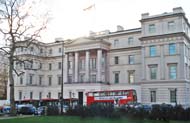
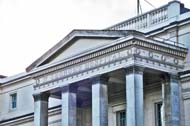
The
east side of the Lanesborough Hotel, as seen from Grosvenor Place.
The central pediment still bears the legend 'St George's Hospital'.
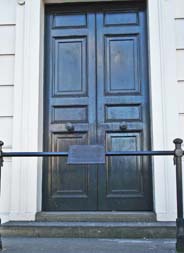
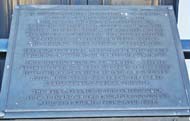
The old main door with a plaque describing the history of the Hospital mounted on a rail in front of it.
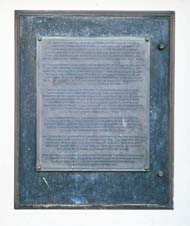
A plaque set in the left hand wall of the central entrance also describes the history of the Hospital.
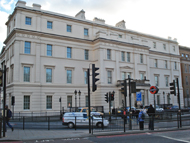
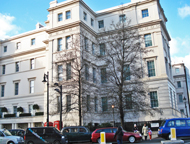
The north side of the Hotel, as seen from Knightsbridge (left), and the south frontage from Grosvenor Crescent (right).
Barry G, Carruthers LA 2005 A History of Britain's Hospitals. Sussex, Book Guild Publishing
https://portal.sgul.ac.uk
www.lanesborough.com
www.stgeorgesfinance.org.uk
www.victorianlondon.org
Return to home page